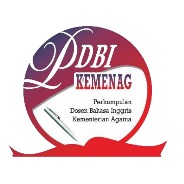Indonesian EFL Teachers Ideologies of Lingua Culture
Abstract
This study aimed at investigating the interpretation of lingua-culture and its depiction in EFL learning based on Indonesian EFL teachers ideologies. This study used an instrumental case study that purposefully engaged ten Indonesian EFL teachers as the participants. A semi-structured interview was assigned to garner the expected data. This study revealed that eight teachers, ones holding an essentialist ideology, interpreted lingua-culture as one language with one culture and depicted it into several characteristics including becoming native-like English users as the goal, using natively authentic materials, framing communicative competence theory for use, and applying indirect cultural teaching. On the contrary, the rest two teachers, ones adhering to a non-essentialist ideology, interpreted lingua-culture as one language with multiple cultures and depicted it into some characteristics extending to becoming intercultural English users as the goal, using cross-cultural non-native English materials, framing intercultural communicative competence for use, and executing direct cultural teaching. As the implication, anchored in the nature of multiculturality of Indonesian students, this study promotes EFL teachers to hold the non-essentialist ideology for its sustainability. This study offers two conceptual frameworks vis-a-vis EFL lingua-culture ideologies. Of the two, there is only one scientifically considered ideal to fit the multiculturality of Indonesian students.
Keywords -EFL learning ideology, lingua-culture, multiculturality
Keywords
Full Text:
PDFReferences
Assemi, A., Saleh, S., Asayeshh, M. E., & Janfaza, E. (2012). Culture within Language. International Conference on Language, Medias and Culture, 33, 78–82.
Barrett, M., Byram, M., Lázár, I., Gaillard, M. P., & Philippou, S. (2014). Developing intercultural competence through education. (J. Huber & C. Reynolds, Eds.) (Vol. 1). Council of Europe Publishing. F67075 Strasbourg Cedex.
Byram, M. (1986). Cultural studies in foreign-language teaching. Language Teaching, 19, 322–336. https://doi.org/10.1017/S0261444800011101
Byram, M. (1997). Teaching and assessing intercultural communicative competence. Frankfurt Lodge, UK: Multilingual Matters LTD.
Byram, M., Gribkova, B., & Starkey, H. (2002). Developing the intercultural dimension in language teaching: A practical introduction for teachers. Strasbourg: The Council of Europe.
Byram, M., & Parmenter, L. (2012). The common european framework of reference: The globalisation of language education policy. Bristol: Multilingual Matters.
Canale, M., & Swain, M. (1980). Theoretical bases of communicative approaches to second language teaching and testing. Applied Linguistics, 1. https://doi.org/10.1093/applin/1.1.1
Chastain, K. (1988). Developing second-language skills. USA: HBJ Publishers.
Crozet, C., & Liddicoat, A. J. (1997). Teaching culture as an integrated part of language: An Introduction. Australian Review of Applied Linguistics, 14, 1–22.
Crozet, C., & Liddicoat, A. J. (1999). The challenge of intercultural language teaching: Engaging with culture in the classroom. In J. Lo
Bianco, A. J. Liddicoat, & C. Crozet (Eds.), Striving for the Third Place: Intercultural Competence through Language Education (p. 113). Melbourne: Language Australia.
Deardorff, D. K. (2006). The identification and assessment of intercultural competence as a student outcome of internationalization at institutions of higher education in the United States. Journal of Studies in International Education, 10, 241–266.
Deardorff, D. K. (2009). The SAGE handbook of intercultural competence. Thousand Oaks, California: SAGE publications, Inc.
Ellis, R. (2000). Task-based research and language pedagogy. Language Teaching Research, 4(3), 193–220. https://doi.org/10.1191/136216800125069
Elmes, D. (2013). The relationship between language and culture. 鹿屋体育大学学術研究紀要, 46, 11–17. https://doi.org/10.1111/j.1467-9280.2009.02412.x
Fang, F. G. (2017). World Englishes or English as a Lingua Franca: Where does English in China stand? English Today, 33(1), 19–24. https://doi.org/10.1017/S0266078415000668
FitzGerald, H. (1999). What culture do we teach? In J. Lo Bianco, A. J. Liddicoat, & C. Crozet (Eds.), Striving for the Third Place: Intercultural Competence through Language Education. (p. 127). Melbourne: Language Australia.
Halliday, M. A. K. (1978). Language as social semiotic. The interpretation of Language andMeaning. London: Edward Arnold.
Hamied, F. A. (2012). English in Multicultural and Multilingual Indonesian Education. Multilingual Education, 1(English as an International Language in Asia: Implications for Language Education), 63–78. https://doi.org/10.1007/978-94-007-4578-0_5
Hua, Z. (2013). Exploring Intercultural Communication. Exploring Intercultural Communication: Language in Action. https://doi.org/10.4324/9780203798539
Hymes, D. (1972). On communicative competence. (J. B. Pride & J. Holmes, Eds.). Harmondsworth: Penguin.
Jenkins, J. (2000). The phonology of English as an international language. TESOL Quarterly. Oxford: Oxford University Press.
Jenkins, J. (2006). Current perspectives on teaching world Englishes and English as a lingua franca. TESOL Quarterly, 40(1), 157. https://doi.org/10.2307/40264515
Kachru, B. B. (1990). World Englishes and applied linguistics. World Englishes, 9(1), 3–20.
Kaplan, R. B. (1966). Cultural thought patterns in inter-cultural education. Language Learning, 16(1 2), 1–20. https://doi.org/10.1111/j.1467-1770.1966.tb00804.x
Kirkpatrick, A. (2008). English as the official working language of the Association of Southeast Asian Nations (ASEAN): Features and strategies. English Today, 24(2), 27–34.
https://doi.org/10.1017/S0266078408000175
Kirkpatrick, A. (2010). English as a lingua franca in ASEAN: A multilingual model. Hong Kong: Hong Kong University Press.
Kirkpatrick, A. (2011). English as an Asian lingua franca and the multilingual model of ELT. Language Teaching, 44(2), 212–224. https://doi.org/10.1017/S0261444810000145
Kramsch, C. (1998). Language and culture. Oxford: Oxford University Press.
Kramsch, C. (2013). Culture in foreign language teaching. Iranian Journal of Language Teaching Research, 1(1), 57–78.
Kramsch, C. J. (1993). Context and culture in language teaching. Oxford: Oxford University Press.
Kusumaningputri, R., & Widodo, H. P. (2018). Promoting Indonesian university students’ critical intercultural awareness in tertiary EAL classrooms: The use of digital photograph-mediated intercultural tasks. System, 72, 49–61. https://doi.org/10.1016/j.system.2017.10.003
Lado, R. (1957). How to compare two cultures. Ann Arbor University of Michigan Press.
Larson, D. N., & Smalley, W. A. (1972). Becoming bilingual: A guide to language learning. New Canaan, C.N: Practical Anthropology.
Lauder, A. (2008). The status and function of English in Indonesia: A review of key factors. Makara, Social Humaniora, 12(1), 9–20.
Leggett, D. (2014). How to Develop Teachers ’ Intercultural Communicative Competence in the 21 st Century Education. ASILE 2014 Conference, 1–6.
Liddicoat, A. J., Papademetre, L., Scarino, A., & Kohler, M. (2003). Intercultural language learning. Australia: Commonwealth Department of Education, Science and Training.
Lidya, F. S. (2016). In pursuit of intercultural communicative competence: An investigation into English language policy and practices at a private university in Indonesia. Australia: Victoria University of Wellington.
Liu, J., & Fang, F. (Gabriel). (2017). Perceptions, awareness and perceived effects of home culture on intercultural communication: Perspectives of university students in China. System, 67, 25–37. https://doi.org/10.1016/j.system.2017.04.003
Miles, M. B., Huberman, A. M., & Saldana, J. (2014). Qualitative data analysis: A methods sourcebook. Thousand Oaks, California 91320: SAGE Publications, Inc.
Newton, J., Yates, E., Shearn, S., & Nowitzki, W. (2010). Intercultural communicative language teaching: Implications for effective teaching and learning. Wellington, New Zealand: School of Linguistics and Applied Language Studies and the Jessie Hetherington Centre for Educational Research, Victoria University of Wellington.
Peck, D. (1998). Teaching culture : Beyond language. Yale-New Haven Teachers Institute. Retrieved from http://teachersinstitute.yale.edu/curriculum/units/1984/3/84.03.06.x.html
Scarino, A., & Liddicoat, A. J. (2009). Teaching and learning languages: A guide. Australia: GEON Impact Printing Pty Ltd. https://doi.org/10.4324/9780203082423
Seidlhofer, B. (2001). Closing A Conceptual Gap: The Case For A Description Of English As A Lingua Franca. International Journal of Applied Linguistics, 11(2), 133–158. https://doi.org/10.1111/1473-4192.00011
Seidlhofer, B. (2005). VOICE (Vienna-Oxford International Corpus of English). Retrieved from http://www.univie.ac.at/voice/
Sukyadi, D. (2015). The teaching of English at secondary schools in Indonesia. Secondary School English Education in Asia: From Policy to Practice, 123–147.
Trivonovitch, G. J. (1980). Culture learning and culture teaching (In Croft,). Cambridge, Mass: Withrop Publishers. Inc.
Turuk, M. C. (2008). The relevance and implications of Vygotsky’s sociocultural theory in the second language classroom. ARECLS, 5, 244–262.
Vygotsky, L. (1978). Interaction between learning and development. Readings on the Development of Children. New York. https://doi.org/10.1016/S0006-3495(96)79572-3
Wardhaugh, R. (2006). An Introduction to Sociolinguistics. Blackwell Textbooks in Linguistics (5th ed.). 350 Main Street, Malden, MA 02148-5020, USA: BLACKWELL PUBLISHING. https://doi.org/10.1353/lan.2003.0268
Wierzbicka, A. (1986). Does language reflect culture? Evidence from Australian English. Language in Society, 15(3), 349–373. https://doi.org/10.1017/S0047404500011805
DOI: http://dx.doi.org/10.29240/ef.v3i01.630
Refbacks
- There are currently no refbacks.
Copyright (c) 2019 Ruly Morganna

This work is licensed under a Creative Commons Attribution-NonCommercial-ShareAlike 4.0 International License.
INDEXED BY:
 This work is licensed under a Creative Commons Attribution-NonCommercial-ShareAlike 4.0 International License
This work is licensed under a Creative Commons Attribution-NonCommercial-ShareAlike 4.0 International License
@ ENGLISH FRANCA : Academic Journal of English Language and Education
Jl. Dr. AK Gani No 1 Dusun Curup, Rejang Lebong Regency, Bengkulu Province, Indonesia, 39119.
Dr. Eka Apriani, M.Pd., email: efranca@iaincurup.ac.id, eka.apriani@iaincurup.ac.id.




.png)












